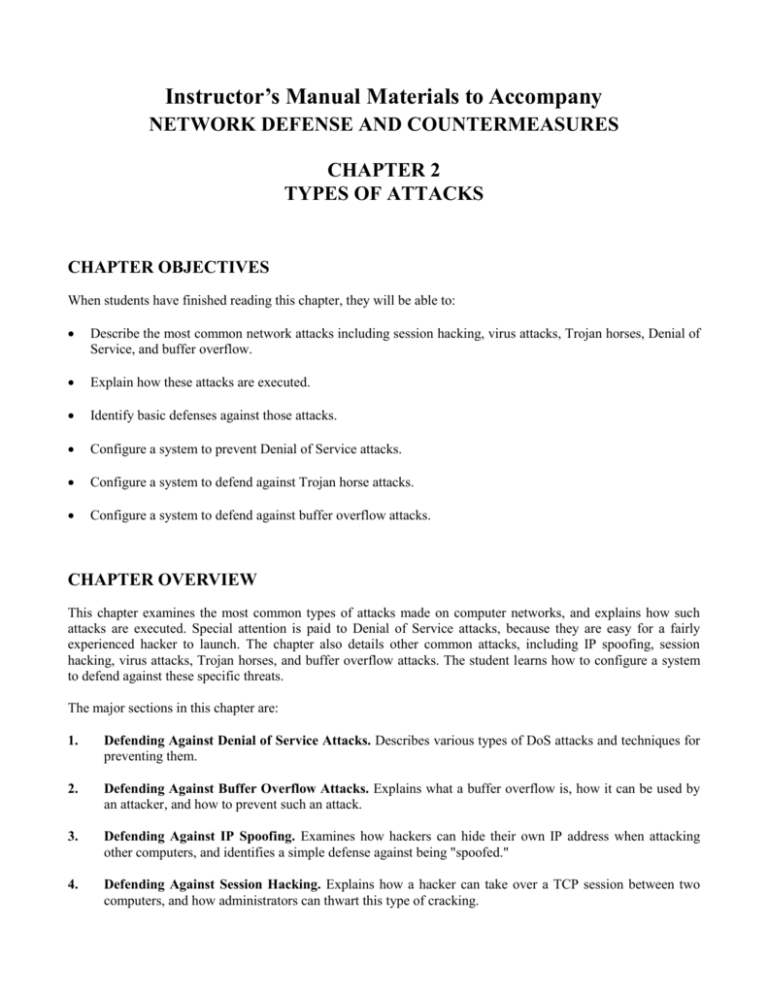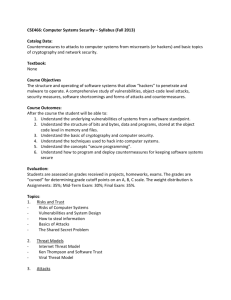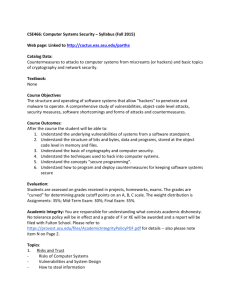
Instructor’s Manual Materials to Accompany
NETWORK DEFENSE AND COUNTERMEASURES
CHAPTER 2
TYPES OF ATTACKS
CHAPTER OBJECTIVES
When students have finished reading this chapter, they will be able to:
Describe the most common network attacks including session hacking, virus attacks, Trojan horses, Denial of
Service, and buffer overflow.
Explain how these attacks are executed.
Identify basic defenses against those attacks.
Configure a system to prevent Denial of Service attacks.
Configure a system to defend against Trojan horse attacks.
Configure a system to defend against buffer overflow attacks.
CHAPTER OVERVIEW
This chapter examines the most common types of attacks made on computer networks, and explains how such
attacks are executed. Special attention is paid to Denial of Service attacks, because they are easy for a fairly
experienced hacker to launch. The chapter also details other common attacks, including IP spoofing, session
hacking, virus attacks, Trojan horses, and buffer overflow attacks. The student learns how to configure a system
to defend against these specific threats.
The major sections in this chapter are:
1.
Defending Against Denial of Service Attacks. Describes various types of DoS attacks and techniques for
preventing them.
2.
Defending Against Buffer Overflow Attacks. Explains what a buffer overflow is, how it can be used by
an attacker, and how to prevent such an attack.
3.
Defending Against IP Spoofing. Examines how hackers can hide their own IP address when attacking
other computers, and identifies a simple defense against being "spoofed."
4.
Defending Against Session Hacking. Explains how a hacker can take over a TCP session between two
computers, and how administrators can thwart this type of cracking.
5.
Blocking Viruses and Trojan Horse Attacks. Provides examples of major virus attacks and the damage
they caused, and describes simple strategies for prevent viruses from reaching your system.
CHAPTER OUTLINE
I.
Chapter Objectives
II.
Introduction
III.
Defending Against Denial of Service Attacks
DoS in Action
SYN Flood
The Smurf Attack
The Ping of Death
Distributed Reflection Denial of Service
DoS Tools
Real World Examples
How to Defend Against DoS Attacks
IV.
Defending Against Buffer Overflow Attacks
V.
Defending Against IP Spoofing
VI.
Defending Against Session Hacking
VII.
Blocking Virus and Trojan Horse Attacks
Viruses
Trojan Horses
IX.
Summary
X.
Test Your Skills
Multiple Choice Questions
Exercises
Projects
TEACHING NOTES
I.
Defending Against Denial of Service Attacks
Teaching Tips: To help students understand the way DoS attacks work and the kind of disruption they
can cause, review some recent examples of real-world DoS attacks. Discuss the types of operational limitations
that render virtually any network vulnerable to this threat.
Teaching Tips: Have a lab system preconfigured so students can perform the example outlined in the
"DoS in Action" section. Follow the appropriate procedure for your system and Web server. If time allows, let
students perform the example themselves. Make sure students know that they should not perform such exercises
on their own computers or on "live" systems belonging to an organization. Labs of this type will shut the system
down, so they should be performed only on a computer or network that is set up specifically for this purpose.
Teaching Tips: To help students grasp the potential scope of a major DDoS attack, tell students that a
well-distributed virus can spread to tens or hundreds of thousands of systems. If the virus is programmed to
launch a DDoS attack at a specific date and time, all the "hijacked" systems attack the target at the same time.
This can result in millions of data packets flooding the target system, bringing it to a halt.
Teaching Tips: Because viruses and Trojan horses can be used as the basis for several kinds of DoS
attacks, it is essential that every computer on a network (especially servers) have antivirus software installed. It is
equally important to make sure that the antivirus programs are kept updated and active at all times.
Teaching Tips: If possible, download and install a popular DoS tool (such as TFN or Trin00) on a lab
machine, so students can explore it and learn how it can be used. If this is possible, and if schedule allows, assign
students to prepare a brief paper or presentation on one aspect of the program. Ask students to share their findings
with the entire class.
Teaching Tips: Divide the class into groups and ask each group to study Blaster, MyDoom, W32.Storm,
or Slammer. Each group should prepare a brief presentation to share with the entire class. Each group's
presentation should focus on the extent of damage caused by the worm and examine deterrents that could have
stopped the worm from spreading. Ask students to analyze this question: In each case, why didn't users and
administrators take stronger steps to avoid infection or to prevent the worm from spreading?
Teaching Tips: Help students understand the severity of blocking all inbound traffic to a network. Such
a step can definitely secure the network from outside attacks, but it may not be practical in many situations. Offer
some examples to help students prepare for Discussion Question 1.
II.
Defending Against Buffer Overflow Attacks
Teaching Tips: If you or any students have programming expertise, write a simple example of code that
utilizes a buffer. (It is only necessary to write the code on a whiteboard so students can see it.) Show students this
example and explain how it functions, to help them understand how programs use buffers and how this can be
exploited by an attacker.
III.
Defending Against IP Spoofing
Teaching Tips: If possible, download Netlog or a similar product and install it on a lab machine, so
students can study it. Show students how the program is installed and how its basic parameters can be set.
IV.
Defending Against Session Hacking
Teaching Tips: Ask students to describe the kinds of tasks a hacker might perform during session
hacking. For example, might a hacker use this technique to intercept e-mail messages being transmitted between
e-mail servers?
V.
Blocking Virus and Trojan Horse Attacks
Teaching Tips: Make sure that students understand the distinctions between viruses, worms, and Trojan
horses. In some cases these distinctions are slight, but it is important to know them in order to properly
differentiate these classes of threats.
Teaching Tips: If you or any students have programming expertise, draw a flowchart of a simple
program that integrates with Microsoft Office programs (as described on p. 55 of the text). The flowchart should
show the steps the program would take to perform its tasks, such as locating a chart in Excel, copying the chart
into a Word document, then e-mailing the resulting document to everyone in the Outlook address book.
Teaching Tips: Viruses can do much more than replicate themselves and send e-mail messages. Lead
students in a discussion of the many types of damage viruses can do. Create a list on the whiteboard and ask
students to contribute to it.
Teaching Tips: It would be very helpful if network administrators could look into the minds of virus
writers, but as the text discusses (in the "FYI" callout box on p. 58), little is actually known about the motivations
of virus writers. Lead students in a discussion about such motivations. If a student could write a virus, what would
it do? What kind of damage would it cause? What reason would the student have for turning it loose?
Teaching Tips: Have any students' computer ever been infected by a virus? Ask students to recount their
experiences with viruses. What kinds of damage did their systems suffer? How could they have prevented the
virus from infecting their systems? What lessons did they learn, and how did the experience change the way they
manage their computers?
PROJECTS/EXERCISES
I.
Discussion Questions
A. Discussion Question 1
As you learned in Chapter 2, one way to secure a network from attack is by blocking all
incoming traffic. But is such a measure practical? Imagine running a network in different types of
organizations (a bank, a university, and others). Would this be the ideal way to protect the
organization's network from attack? Why or why not?
Answer: Students’ answers may vary. There should be a discussion of the importance of various
kinds of traffic to different types of organizations. For example, many banks offer online services
to customers, making inbound traffic essential. But the same might not be true for a small business
such as a shoe store. Students should also discuss other types of security measures that should be
taken when traffic blocking is not practical.
B. Discussion Question 2
Perhaps you have seen the TV commercial in which a bored office worker unthinkingly
opens an e-mail message, which launches a virus on her computer. The virus immediately spreads
to her coworkers' computers and chaos breaks out in the office. The commercial may be overly
dramatic (or comic, depending on you point of view), but it raises an important question: should a
worker be held responsible for bringing a virus into an organization's network, even by accident?
If so, what penalties would be reasonable? How can organizations prevent such incidents?
Answer: Students' answers will likely vary, but the discussion here should focus on the
accountability of users for creating such problems and the methods managers can employ to
prevent these problems. Steer the discussion away from technological solutions, helping students
concentrate on human resources and policy-related solutions.
II.
Web Projects
A. Web Project 1
Visit a variety of security-related Web sites and try to find out how common Denial of
Service attacks occur.
Answer: Students' answers will vary, depending on the resources they use. For example, in its
"State of Internet Security" report for 2005, Symantec's Small Business Web site (at
http://www.symantec.com/small_business/library/security_state.html) reports that 927 DoS attacks
occurred each day between Jan. 1, 2005 and June 30, 2005. Other information sources provide
various numbers. Successful students will learn that such attacks are very common and remain on
the rise, affecting organizations of all sizes, not just large corporations.
B. Web Project 2
Search the United States Computer Emergency Readiness Team (US-CERT) Web site, at
http://www.us-cert.gov/ for information about buffer overflow attacks. How many programs or
operating systems can you identify that are vulnerable to this type of attack?
Answer: Students' answers will vary, but every student should show evidence of having done a
thorough search of the site. US-CERT has catalogued a number of buffer overflow vulnerabilities
in a variety of software programs and has issued warnings about many of them. These warnings
generally include technical details about the program as well as procedures for fixing them.
C. Web Project 3
Using your favorite search engine, such as Google (http://www.google.com/) or Yahoo,
(http://www.yahoo.com/), do some research on monitoring programs such as Netlog and others
like it. How do such programs work? Are they specifically for certain types of networks or
operating systems? Which one would be most useful in a given environment? Be prepared to
share your findings with the class.
Answer: Students' answers will vary, but should show evidence of thorough, independent research
using any online sources they can find. Students should have a good idea of how Netlog and
similar tools work and in which environments they might be most useful.
D. Web Project 4
Do you know how to update an antivirus program? Many commercial antivirus programs
can automatically update themselves, if the user subscribes to this service. Even so, most AV
programs can be updated manually by visiting the vendor's Web site, finding the update
instructions for your product, and following the required steps. Visit the Web site of the AV
program that is installed on your lab or home PC, and update it manually. Write a paragraph that
describes your experience.
Answer: Successful students will be able to determine which antivirus program is installed on their
PC, locate the vendor's Web site, and manually download the latest updates to the program. The
difficulty of this task will depend on the program, the vendor, and the types/number of updates
available. Students should describe the process, the difficulty level, any problems encountered, and
their ultimate success or failure.
WEB RESOURCES
http://www.247.prenhall.com/ Pearson/Prentice Hall product support
http://www.us-cert.gov/ The United States Computer Emergency Readiness Team site; a respected
security resource provided by the U.S. Department of Homeland Security
http://ciac.llnl.gov/ciac/ToolsUnixNetMon.html The Computer Incident Advisory Capability site of the
U.S. Department of Energy; this page offers introductory information on network monitoring programs
such as Netlog, NETMAN, and others
http://www.f-secure.com/virus-info/virus-news/
viruses
http://www.sarc.com/ The Symantec Security Response Web site, filled with up-to-date information on
current virus threats and information on updating Norton Security products
http://www.denialinfo.com/dos.html A list of informative resources on Denial of Service attacks
An authoritative clearinghouse of information about
CHAPTER REVIEW/ANSWERS TO TEST YOUR SKILLS
Multiple Choice Questions
1.
From the attackers point of view, what is the primary weakness in a Denial of Service attack?
A
2.
What DoS attack is based on leaving connections half open?
D
3.
What is the name for a DoS defense that is dependent on sending back a hash code to the client?
C
4.
Which of the following would be the best defense if your Web server had limited resources but you needed
a strong defense against DoS?
B
5.
What is a technical weakness of the Stack tweaking defense?
B
6.
What is the name for a DoS attack that causes machines on a network to initiate a DoS against one of that
networks servers?
A
7.
Which of the following virus attacks initiated a DoS attack?
D
8.
Which of the following is a recommended configuration of your firewall to defend against DoS attacks?
A
9.
Which of the following best describes a buffer overflow attack?
B
10.
What is the best way to defend against a buffer overflow?
C
11.
Which of the following is the best definition for IP spoofing?
A
12.
What is the danger inherent in IP spoofing attacks?
D
13.
What is the best method of defending against IP spoofing?
A
14.
Which of the following best describes session hacking?
C
15.
Which of the following is the best definition of a virus?
B
16.
What was the greatest danger from the Bagle virus?
A
17.
What is a Trojan Horse?
B
Exercises
EXERCISE 2.1: A BASIC DOS ATTACK
This exercise is procedural. Simply following the appropriate steps should bring the student to a successful
outcome.
EXERCISE 2.2: CONFIGURING A FIREWALL
This exercise is procedural. Simply following the appropriate steps should bring the student to a successful
outcome.
EXERCISE 2.3: INSTALLING NORTON ANTI VIRUS
The first part of this exercise is simply procedural, successfully installing and configuring the software in
question. The second part requires the student to perform some analysis. The key in this exercise is that the
student have rational reasons, and supporting data, for whatever conclusion is arrived at.
EXERCISE 2.4: CONFIGURING A ROUTER
This exercise is procedural. Simply following the appropriate steps should bring the student to a successful
outcome.
EXERCISE 2.5: LEARNING ABOUT BLASTER
The key to this exercise is that the student come up with recommendations that are specific to this particular virus.
Simply indicating that users should employ antivirus software is not enough. There must be specific
recommendations about this specific virus.
EXERCISE 2.6: LEARNING ABOUT MYDOOM
The key to this exercise is that the student come up with recommendations that are specific to this particular virus.
Simply indicating that users should employ anti virus software is not enough. There must be specific
recommendations about this specific virus.
Projects
PROJECT 2.1 THE MOST RECENT VIRUS ATTACKS
The key to this project is detail. The more detail about the virus the student can provide the better.
PROJECT 2.2 SETTING UP ANTI VIRUS POLICY
The student must notice things beyond simply using virus scanners. The student should have recommendations
regarding the downloading of software, handing attachments, and use of firewalls.
PROJECT 2.3 WHY DO BUFFER OVERFLOW VULNERABILITIES EXIST?
The student should note reasons which lead to lower quality of software. Such reasons might include inadequate
testing, rush to market, etc.
Case Study
The student should also make recommendations regarding the opening of e-mail attachments, the frequency of
updating the antivirus software, etc.





